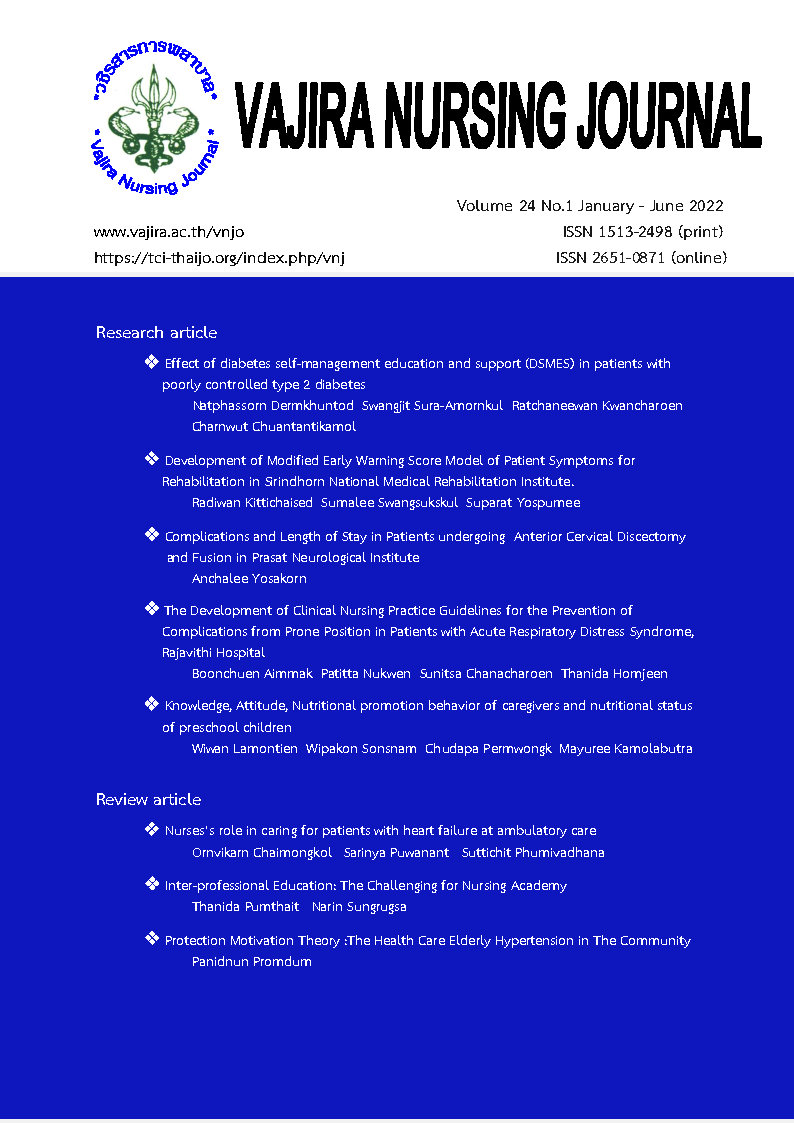การเรียนรู้แบบสหวิชาชีพ: ความท้าทายของสถาบันการศึกษาพยาบาล
Main Article Content
บทคัดย่อ
สถานการณ์ทางสุขภาพ และความเจ็บป่วยของผู้คนในยุคนี้มีการเปลี่ยนแปลงอย่างฉับพลัน เร่งด่วนและสลับซับซ้อนในหลายมิติ แนวทางการรักษาพยาบาลจึงต้องปรับเปลี่ยนให้เท่าทัน และสอดคล้องกับการเปลี่ยนแปลงที่เกิดขึ้น บุคลากรทางสุขภาพ ต้องมีการใช้องค์ความรู้ ทักษะ จากหลายศาสตร์มาบูรณาการ เชื่อมโยงกันในการให้การรักษาพยาบาลผู้ป่วย โดยยึดผู้ป่วยเป็นศูนย์กลาง การเรียนรู้แบบสหวิชาชีพ (Inter-professional Education) เป็นการเรียนรู้ที่ส่งเสริมให้ผู้เรียนได้มีโอกาสเรียนรู้ร่วมกันผ่านมุมมอง และประสบการณ์การดูแลสุขภาพของวิชาชีพอื่น ๆ ผู้เรียนมีโอกาสในการใช้ศักยภาพที่เรียนมาให้เกิดประโยชน์สูงสุด ซึ่งไม่สามารถเกิดขึ้นได้จากการเรียนเพียงวิชาชีพเดียว และที่สําคัญ คือได้เห็นคุณค่าต่อวิชาชีพของผู้อื่น มีทัศนคติที่ดีต่อวิชาชีพของตน และวิชาชีพอื่น เกิดการประสานความร่วมมือสนับสนุนช่วยเหลือซึ่งกันและกัน ภายใต้สถานการณ์เดียวกัน โดยมีเป้าหมายสุดท้ายตรงกัน คือ ประชาชนมีสุขภาพดี พึ่งพาตนเองได้ ดังนั้น การเตรียมบุคลากรทางสุขภาพที่มีคุณภาพ สอดคล้องกับการเปลี่ยนแปลงของโลก จึงเป็นสิ่งสำคัญ และเป็นความท้าทายอย่างมากสำหรับสถาบันการศึกษาพยาบาล
Article Details

อนุญาตภายใต้เงื่อนไข Creative Commons Attribution-NonCommercial-NoDerivatives 4.0 International License.
เนื้อหาและข้อมูลในบทความที่ลงตีพิมพ์ในวชิรสารการพยาบาลถือเป็นข้อคิดเห็นและความรับผิดชอบของผู้เขียนบทความโดยตรง ซึ่งกองบรรณาธิการไม่จำเป็นต้องเห็นด้วย หรือร่วมรับผิดชอบใด ๆ ทั้งสิ้น
บทความ ข้อมูล เนื้อหา รูปภาพ ฯลฯ ที่ได้รับการตีพิมพ์ในวชิรสารการพยาบาล ถือเป็นลิขสิทธิ์ของวชิรสารการพยาบาล หากบุคคลใดหรือหน่วยงานใดต้องการนำทั้งหมดหรือส่วนหนึ่งส่วนใดไปเผยแพร่ต่อหรือเพื่อกระทำการใด ๆ จะต้องได้รับอนุญาตเป็นลายลักอักษรจากวชิรสารการพยาบาลก่อนเท่านั้น
เอกสารอ้างอิง
กมลทิพย์ ตั้งหลักมั่นคง, อัจฉรา คำมะทิตย์, นพรัตน์ ธรรมวงษาและ อัจฉรา อาสน์ปาสา. (2562). ผลการใช้รูปแบบการเรียนการสอนวิชานวัตกรรมทางการพยาบาลด้วยการเรียนรู้แบบสหสาขาอาชีพต่อความพร้อมต่อการเรียนรู้แบบสหสาขาอาชีพและทักษะแห่งศตวรรษที่ 21. วารสารเครือข่ายวิทยาลัยพยาบาลและการสาธารณสุขภาคใต้, 6(2), 126-139.
กีรติ กิจธีระวุฒิวงษ์ และนิทรา กิจธีระวุฒิวงษ์. (2563). การนำการศึกษาแบบสหสาขาวิชาชีพไปปฏิบัติสำหรับการศึกษาวิชาชีพด้านสุขภาพ. วารสารพยาบาลกระทรวงสาธารณสุข, 30(3), 23 – 34.
เกษร สําเภาทอง. (2562). เรียนรู้ข้ามสาขา เข้าใจคุณค่าทุกวิชาชีพ "IPE" หลักสูตรพัฒนานักศึกษา 7 คณะ กลุ่มสุขศาสตร์. สืบค้นวันที่ 10 พฤศจิกายน 2564 จาก https:// tu.ac.th/ thammasat- ipe-course-for-7-faculty-health-science.
ชนัตถา พลอยเลื่อมแสง, ชญานิษฐ์ สีหนาท และดุสิตา ไชยธรรม. (2563). ผลลัพธ์และผล ประโยชน์ของการเรียนการสอนร่วมสหวิชาชีพ. วารสารเภสัชศาสตร์อีสาน, 16(3), 1 – 14.
ณัฐนันท์ วรสุข, สุริยะ ปิยผดุงกิจ และ สูติเทพ ศิริพิพัฒนกุล. (2563). ผลการจัดการเรียนการสอนแบบสหสาขาวิชาชีพต่อสมรรถนะการทำงานร่วมกันแบบสหสาขาวิชาชีพและความสุขของนักศึกษา. วารสารพยาบาลกระทรวงสาธารณสุข, 30(3), 50–61.
ดนยา สุเวทเวทิน. (2560). ผลักดัน “การเรียนรู้แบบสหวิชาชีพ” สำนักงานกองทุนสนับสนุนการสร้างเสริมสุขภาพ (สสส). สืบค้นวันที่ 11/11/2564 จาก https://www.thaihealth. or.th/ Content/37447.
ธัญญมล สุริยานิมิตรสุข, ทุติยรัตน์ รื่นเริง, เอกพจน์ สืบญาติ, เครือวัลย์ แพทนัทธและอัจฉราวรรณ ยิ้มยัง. (2563). ผลการจัดการเรียนการสอนแบบสหสาขาวิชาชีพ (IPE) เรื่องการส่งเสริมสุขภาพ หญิงตั้งครรภ์ปกติต่อสมรรถนะใน การทำงานร่วมกันแบบสหสาขาวิชาชีพ. วารสารพยาบาลตำรวจ, 12(2), 380-387.
ธวัชชัย ยืนยาว, จุฬารัตน์ ห้าวหาญ และ วรนาถ พรหมศวร. (2562). ผลการจัดการศึกษาแบบสหสาขาวิชาชีพต่อการรับรู้และเข้าใจบทบาทตามสาขาวิชาชีพ และความสามารถ ในการทํางานเป็นทีม. วารสารการพยาบาลการสาธารณสุขและการศึกษา, 20(1), 137– 147.
ปรัชญา พุมอุทยัวิรัตน์. (2563). การจัดการศึกษาแบบสหสาขาวิชาชีพ. The Journal of Chulabhorn Royal Academy eISSN 2697-5203 (online), 2(2), 12-24.
รัชฎา สหะวรกุลศักดิ์, ศิรินาถ ตงศิริ และหทัยชนก ประดิษฐ์ผล. (2564). ปัจจัยความสำเร็จและความท้าทายในการพัฒนากิจกรรมการเรียนร่วมสหสาขาวิชาชีพของศูนย์แพทยศาสตร์ ศึกษาชั้นคลินิก โรงพยาบาลเจ้าพระยาอภัยภูเบศรและเครือข่าย. บูรพาเวชสาร, 8(1), 95 – 111.
วณิชา ชื่นกองแก้ว. (2561). การศึกษาแบบสหวิชาชีพ (พิมพ์ครั้งที่ 2). กรุงเทพฯ: บริษัท พี.เอ.ลีฟวิ่ง จำกัด
สภาการพยาบาล. (2562). ราชกิจจานุเบกษา:ข้อบังคับสภาการพยาบาลว่าด้วยหลักเกณฑ์การรับรองสถาบันการศึกษาวิชาการพยาบาลและการ
ผดุงครรภ์ พ.ศ. 2562. สืบค้นวันที่ 11/11/2564 จากhttps://www.tnmc.or.th/Images/ userfiles / files/ 2562(2).PDF.
สภาการพยาบาล. (2564). สถาบันการศึกษาที่ทำการสอนหลักสูตรพยาบาลศาสตร์บัณฑิตได้รับการรับรองจากสภาการพยาบาลผู้สำเร็จการศึกษามีสิทธิสมัครสอบเพื่อขึ้นทะเบียน และรับใบอนุญาตเป็นผู้ประกอบวิชาชีพฯ (สถาบันที่มีผู้สำเร็จการศึกษาแล้ว). สืบค้นวันที่ 11/11/2564 จากhttps://www.tnmc. or.th/images/userfiles/ files/1_1(21).pdf.
สริญา อยู่สุข. (2562). เรียนรู้ข้ามสาขา เข้าใจคุณค่าทุกวิชาชีพ "IPE" หลักสูตรพัฒนานักศึกษา 7 คณะ กลุ่มสุขศาสตร์. สืบค้นวันที่ 10 พฤศจิกายน 2564 จาก https://tu.ac.th/ thammasat- ipe-course-for-7-faculty-health-science.
สุณี เศรษฐเสถียร. (2558). รูปแบบการเรียนแบบ สหวิชาชีพ ณ กลุ่มงานเวชกรรมฟื้นฟู โรงพยาบาลอุดรธานี. เวชศาสตร์ฟื้นฟูสาร, 25(2), 65-70.
อติญาณ์ ศรเกษตริน, อัจฉราวดี ศรียะศักดิ์, วารุณี เกตุอินทร์ และดาราวรรณ รองเมือง. (2562). การพัฒนารูปแบบการเรียนรู้แบบสหวิชาชีพในการส่งเสริมสุขภาพผู้สูงอายุในชุมชน. วารสารวิจัยสุขภาพและการพยาบาล, 35(2), 140-152.
อนัญญา คูอาริยะกุล, สุชาดา อินทรกำแหง ณ ราชสีมา, อัศนี วันชัย, สมาภรณ์ เทียนขาว, สิรีวัฒน์ อายุวัฒน์, ประกฤต ประภาอินทร์ และนิชดา สารถวัลย์แพศย์. (2563). ประสบการณ์ของนักศึกษาที่เข้าร่วมกิจกรรมการจัดการเรียนการสอนแบบสหสาขาวิชาชีพ: การวิจัยเชิงคุณภาพ. วารสารเครือข่ายวิทยาลัยพยาบาลและการสาธารณสุขภาคใต้, 7(3), 155 – 167.
อัศนี วันชัย, วรรณภา ประทุมโทน, พนารัตน์ เจนจบ, อัญชลี แก้วสระศรี, ดวงพร หุ่นตระกูล, นันทวรรณ ธีระพงศ์, และมณฑา อุดมเลิศ. (2563). วารสารวิจัยสุขภาพและการพยาบาล, 36(2), 190 – 201.
Chuenkongkaew W. (2013). The report on the annual national health professional education reform. Retrieved by 11/11/2021 from http://www.health professionals21thailand.org/.
Dubsok, P. (2014). Development of HIV/AIDS services ystem by multidisciplinary team and HIV peer group in Khunhan Hospital, Si Sa Ket Province. Journal of Health Science, 23(4), 667-676.
Illingworth P., & Chelvanayagam S. (2007). Benefits of interprofessional education in health care. British. Journal of Nursing, 16(2), 121-124. doi: 10.12968/ bjon.2007. 16.2.22773.
Glomjai, T., Ananchaipattana, N., & Chachvarat, T. (2020). The development of learning activities of transprofessional education (TPE) for caring of depending elderly people. Nursing Public Health and Education Journal, 21(1), 125-138.
Putthasri W, Chuenkongkaew W. (2017). The report on 3rd annual national health professional education reform forum: ANHPERF "IPE towards Thai Health Team". Nonthaburi: P.A Living Ltd.
Ray, A., Ray, S., Daniel, S., M., & Kumar, B. (2021). Change in attitudes and perceptions of undergraduate health profession students towards inter-professional education following an educational experience in postnatal care. Medical Journal Armed Forces India, 77(7). S173 - S179.
Rajiah, K., & Maharajan, M. (2016). Frammework for Action to Implement Interprofessional Education and Collaborative Practice in Pharmacy and Allied Health Sciences Program in India. India Journal of Phamaceutical Education and Research, 50(2), 238-245.
Roslan NS, Yusoff M, Rahim AF, Hussin ZA. (2016). Together we stand, divided we fall: Interprofessional collaborative practice competencies from Malaysian medical professionals’ perspectives. J Taibah University Med Sci, 11(6):533-40.
Wilhelmsson M, Pelling S, Uhlin L, Owe Dahlgren L, Faresjö T, & Forslund K. (2020). How to think about interprofessional competence: a metacognitive model. Journal Interprof Care, 26(2), 85-91. Doi : 10.3109/ 13561820. 2011. 644644. Epub 2012 Jan 11. PMID: 22236489.
World Health Organization. (2010). Framework for Action on Interprofessional Education & Collaborative Practice. Switzerland: CH-1211 Geneva 27 from file:///C:/Users/ Admins/Downloads/WHO_HRH_ HPN_10.3_eng.pdf
World Health Organization. (2020). WHO Director-General’s opening remarks at the media briefing on COVID-19. Retrieved by 11/11/ 2021 from https:// www.who.int/dg/speeches/detail/
Zechariah S., Ansa B.E., Johnson S. W., Gates A. M., Leo G.D. (2019). Interprofessional Education and Collaboration in Healthcare: An Exploratory Study of the Perspectives of Medical Students in the United States. Healthcare (Basel). 7(4): 117. doi: 10.3390/ healthcare 7040117. PMID: 31618920; PMCID: PMC6956332.
Zwarestein, Reeves, Barr, Hammick, Koppel, & Atkins. (2000). Interprofessional Education: Effects on Professional Practice and Health Care Outcomes. Retrieved by 7/4/2022 from https:// www.ncbi.nlm. nih.gov/pubmed/11279759.

